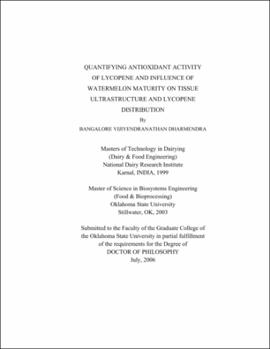| dc.contributor.advisor | McGlynn, William G. | |
| dc.contributor.author | Dharmendra, Bangalore Vijiyendranathan | |
| dc.date.accessioned | 2013-11-26T08:22:33Z | |
| dc.date.available | 2013-11-26T08:22:33Z | |
| dc.date.issued | 2006-07 | |
| dc.identifier.uri | https://hdl.handle.net/11244/6594 | |
| dc.description.abstract | Scope and Method of Study: Lycopene, a lipophilic antioxidant, plays a crucial role in biological systems. Watermelon, a natural source of lycopene (~48.7µg/g), could be a useful ingredient in functional foods. Correlating lycopene concentration in a food product with its antioxidant activity would hence be critical in determining effective and economical rates of lycopene addition. Also, it is necessary to understand the association of lycopene with other structural organelles during melon maturation, while designing processes to maximize lycopene retention in watermelon-based extracts and/or functional foods. The objectives outlined in this study include: (i & ii)
correlating the antioxidant activity of lycopene with lycopene concentration using the a modified ORACFL assay involving the use of β-cyclodextrin (β-CD) and randomly methylated β-cyclodextrin (RMCD) separately as solubility enhancers (iii) studying watermelon ultrastructure and relating melon maturity to the distribution and organization of lycopene within structural organelles in watermelon mesocarp. Lycopene was extracted (from Lyc-O-MatoTM 6% extract) by a modified spectrophotometric assay developed by inclusion of β-CD and RMCD separately (at concentrations of 0, 0.4, 0.8 & 1.6 %) and the antioxidant activity of lycopene measured with ORACFL assay. Experiments were conducted in quadruplicate and statistical pooled correlations analyzed. Also for the third objective study employed Transmission Electron Microscopy (TEM) to conduct research on the ultrastructure of watermelon mesocarp for watermelon obtained at different maturities. | |
| dc.description.abstract | Findings and Conclusions: Lycopene concentration correlated poorly with ORACFL (R2=0.33) in the absence of either β-CD or RMCD. Correlations improved both with increasing levels of β-CD (R2=0.58 and 0.91 for 0.4 and 0.8 % β-CD respectively) and RMCD (R2=0.9284 and 0.9959 for 0.4 and 0.8 % RMCD respectively). A very high β-CD concentration (1.6%) decreased the correlation between ORAC and lycopene concentration. Inclusion of cyclodextrins in ORACFL assay improves correlation between ORAC and lycopene concentration, thus expanding the scope of the ORACFL assay for similar other fat soluble antioxidants. Electron micrographs from TEM studies showed chromoplasts changing from less organized globular form in immature to a definite, symmetrical form in mature and finally to an asymmetrical structure in over-mature melons. | |
| dc.format | application/pdf | |
| dc.language | en_US | |
| dc.rights | Copyright is held by the author who has granted the Oklahoma State University Library the non-exclusive right to share this material in its institutional repository. Contact Digital Library Services at lib-dls@okstate.edu or 405-744-9161 for the permission policy on the use, reproduction or distribution of this material. | |
| dc.title | Quantifying antioxidant activity of lycopene and influence of watermelon maturity on tissue ultrastructure and lycopene distribution | |
| dc.contributor.committeeMember | Brandenberger, Lynn Philip | |
| dc.contributor.committeeMember | Maness, Niels O. | |
| dc.contributor.committeeMember | Bellmer, Danielle | |
| osu.filename | Dharmendra_okstate_0664D_1887.pdf | |
| osu.accesstype | Open Access | |
| dc.type.genre | Dissertation | |
| dc.type.material | Text | |
| dc.subject.keywords | watermelon | |
| dc.subject.keywords | ORAC | |
| dc.subject.keywords | lycopene | |
| dc.subject.keywords | lipophilic antioxidants | |
| dc.subject.keywords | ?-cyclodextrin | |
| dc.subject.keywords | ultrastructure | |
| thesis.degree.discipline | Food Science | |
| thesis.degree.grantor | Oklahoma State University | |
